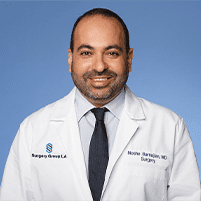Pilonidal Cyst Specialist

Moshe Barnajian, MD
Minimally Invasive and Robotic Colorectal Surgeon based at Cedars Sinai, Los Angeles
Medically known as sacrococcygeal fistula, a pilonidal cyst is an abnormal, often infected pocket that develops near your tailbone. If you’re experiencing pain or drainage near your tailbone, contact the office of Moshe Barnajian, MD, in the Beverly Grove area of Los Angeles, California, for a pilonidal cyst evaluation. Click on the online scheduling tool, or call this West Hollywood-based colorectal surgery practice today.
Pilonidal Cyst Q & A
What causes a pilonidal cyst?
A chronic skin infection that forms near your tailbone in the top crease of your buttocks, a pilonidal cyst is known for causing excruciating pain. They develop when hairs in the cleft of your buttocks grow into your skin and become infected.
The term “pilonidal” stems from the Latin words pilus and nidus, or hair and nest, which describes the cyst that’s filled with hairs and debris.
Though anyone can suffer from a painful, inflamed pilonidal cyst, this condition affects men more commonly than women. Pilonidal cysts are also more prevalent among young adults in their 20s. Your risk further increases due to:
- Being overweight
- Sedentary lifestyle
- Sitting for long periods
- Naturally stiff, coarse hair
Without proper treatment, a pilonidal cyst can become seriously infected and make you quite ill. Because of this, it’s important to understand the signs and symptoms of a pilonidal cyst and get started on treatment early on.
What are the symptoms of a pilonidal cyst?
A pilonidal cyst usually begins as unusual pain around your tailbone. Even the pressure from sitting can become uncomfortable. It’s important to come in to the office of Moshe Barnajian, MD, if this issue sounds familiar, especially if you also experience any of the following symptoms:
- Visible mass
- Pus and drainage that may contain blood
- Redness at the cleft of your buttocks
If an infection ensues, you may develop flu-like symptoms, too. An infected pilonidal cyst is known for causing fever, nausea, and vomiting.
How does a doctor treat a pilonidal cyst?
The proper treatment for a pilonidal cyst depends on the disease pattern. In minor cases, an abscess can resolve with medical intervention and thorough cleaning of the area. But if a pilonidal sinus develops below the cyst, you’re left with a small opening that needs to be treated surgically.
Depending on the severity of your pilonidal cyst, Dr. Barnajian may decide to leave the surgical wound open or closed. Leaving your treated pilonidal cyst open means that Dr. Barnajian packs the opening with sterile dressing, which forces it to heal naturally from the inside. Your recovery time is longer, but your risk of recurrence is much lower.
Closing your pilonidal cyst wound involves placing sutures to close up the incision after surgery. Healing is faster in this case, although you may have a higher chance of developing another pilonidal cyst in the future.
If you’re experiencing symptoms of a pilonidal cyst, contact the office of Moshe Barnajian, MD, as soon as possible. You can schedule an exam through the website or over the phone.
What causes a pilonidal cyst?
A chronic skin infection that forms near your tailbone in the top crease of your buttocks, a pilonidal cyst is known for causing excruciating pain. They develop when hairs in the cleft of your buttocks grow into your skin and become infected.
The term “pilonidal” stems from the Latin words pilus and nidus, or hair and nest, which describes the cyst that’s filled with hairs and debris.
Though anyone can suffer from a painful, inflamed pilonidal cyst, this condition affects men more commonly than women. Pilonidal cysts are also more prevalent among young adults in their 20s. Your risk further increases due to:
- Being overweight
- Sedentary lifestyle
- Sitting for long periods
- Naturally stiff, coarse hair
Without proper treatment, a pilonidal cyst can become seriously infected and make you quite ill. Because of this, it’s important to understand the signs and symptoms of a pilonidal cyst and get started on treatment early on.
What are the symptoms of a pilonidal cyst?
A pilonidal cyst usually begins as unusual pain around your tailbone. Even the pressure from sitting can become uncomfortable. It’s important to come in to the office of Moshe Barnajian, MD, if this issue sounds familiar, especially if you also experience any of the following symptoms:
- Visible mass
- Pus and drainage that may contain blood
- Redness at the cleft of your buttocks
If an infection ensues, you may develop flu-like symptoms, too. An infected pilonidal cyst is known for causing fever, nausea, and vomiting.
How does a doctor treat a pilonidal cyst?
The proper treatment for a pilonidal cyst depends on the disease pattern. In minor cases, an abscess can resolve with medical intervention and thorough cleaning of the area. But if a pilonidal sinus develops below the cyst, you’re left with a small opening that needs to be treated surgically.
Depending on the severity of your pilonidal cyst, Dr. Barnajian may decide to leave the surgical wound open or closed. Leaving your treated pilonidal cyst open means that Dr. Barnajian packs the opening with sterile dressing, which forces it to heal naturally from the inside. Your recovery time is longer, but your risk of recurrence is much lower.
Closing your pilonidal cyst wound involves placing sutures to close up the incision after surgery. Healing is faster in this case, although you may have a higher chance of developing another pilonidal cyst in the future.
If you’re experiencing symptoms of a pilonidal cyst, contact the office of Moshe Barnajian, MD, as soon as possible. You can schedule an exam through the website or over the phone.
